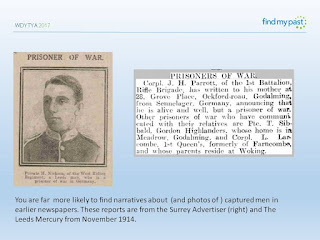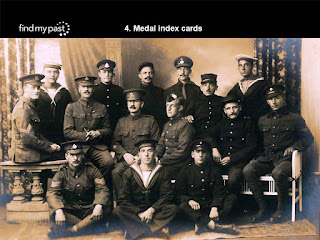Here's the slide-deck from the talk I gave on behalf of Findmypast at yesterday's WDYTYA session at the NEC in Birmingham. To all those who attended, thank you for coming.
Searching from the home page is only a realistic option if you are looking for an individual with an uncommon name. I have referred to Vernon Swatman in two posts on my Army Forms and Attestations blog. Here's one of those: Vernon Swatman's medical chart.
The documents you can typically expect to see returned in search results are transcriptions, images and PDFs.
From the home page select the search option and then choose whether to search across all records, search by category, or use the A-Z search (below).
The importance of wildcard searching cannot be under-stated. It is an extremely flexible and useful tool and you should use it with abandon. Failing to do so can seriously limit the results you can expect to see returned. The Argyll and Sutherland Highlanders example below is a good example of this. Use the wildcard asterisk * with as many or as few letters as you like - and use it before and after text.
There are a number of stand-out series in Findmypast's Prisoners of War collection which covers the period 1715 to 1945. I drew attention to the records in WO 161 at The National Archives which is a series of PoW interviews conducted before the Armistice with men who had been interned, repatriated, or who had escaped. I have posted separately on Prisoner of War reports in WO 161 and included copies of the questions that were asked. This is a TERRIFIC series, worthy of serious study (not to mention further indexing).
The arrows in the image indicate the PoWs British Army cap badges and their tin badges which bear their PoW numbers.
It is common to see "P of W" written on the cards of many men who were captured in 1914; less common to see this on cards of men who were captured later than 1914. The number in the top left hand corner is an anachronistic reference to the regiment of foot; in this case the 50th regiment of Foot which was the pre July 1881 designation of the Royal West Kent Regiment.
A good example of a man with records in WO 364 (on the left) and WO 363 (the so-called "burnt documents"). The images below and in the slide after that, are Crown Copyright, The National Archives.
The images in the next two slides are also Crown Copyright, The National Archives.
The ICRC PoW collection is important but challenging to use. This is a site that would certainly benefit from improved indexing.
Some images give a wealth of information. In the example above, in the space of three short lines, we are told date of birth, next of kin, date of capture, place of capture, the fact that the man was unwounded, and the company he was serving in. Terrific information.
This is not my image and I apologise for any infringement of copyright.
The screen grab above is from the auctioneers, Spink & Son.
Libraries probably hold out the nest hope of getting access to the Gale Cengage data. It is here that you will find images (albeit poor quality) of those lists of men who had become PoWs on or before 25th December 1914. Read more about this on my 1914 PoWs page.
The Great War Forum is a great resource, as is The Long, Long Trail website and the Western Front Association site.
As well as the book above, also check out the British Red Cross and Order of St John Enquiry lists which are held by the IWM and which have been re-published by N&MP.
You are welcome to use and refer to these slides for your own non-commercial usage but I retain the copyright in the content and soldier images unless otherwise stated.
And remember, I research soldiers!
























































2 comments:
What a nice presentation. It's a shame that went to WDYTYA on Friday as it would have been nice to hear the talk as well.
Sorry you missed it, but thanks for your kind words.
Post a Comment